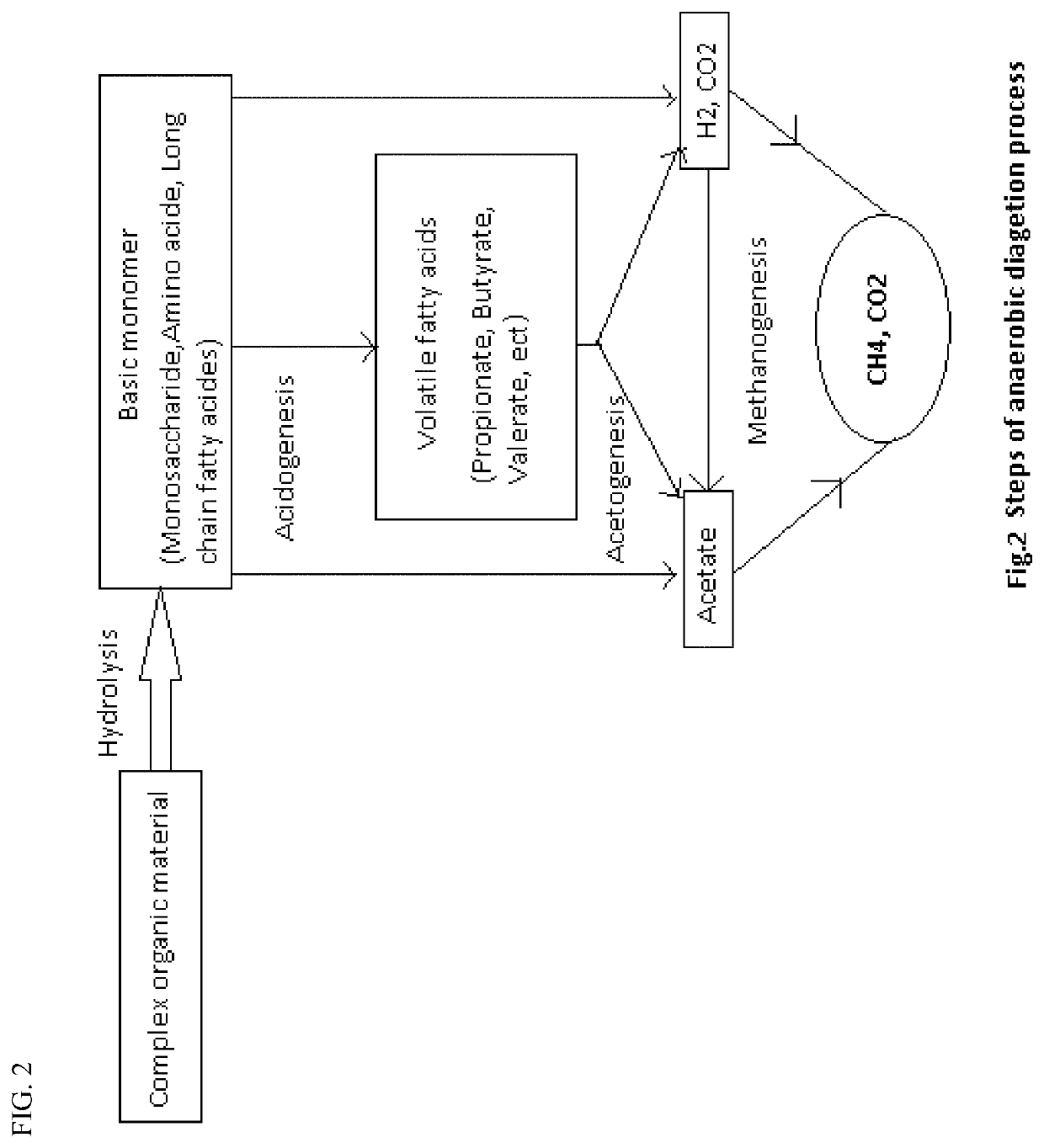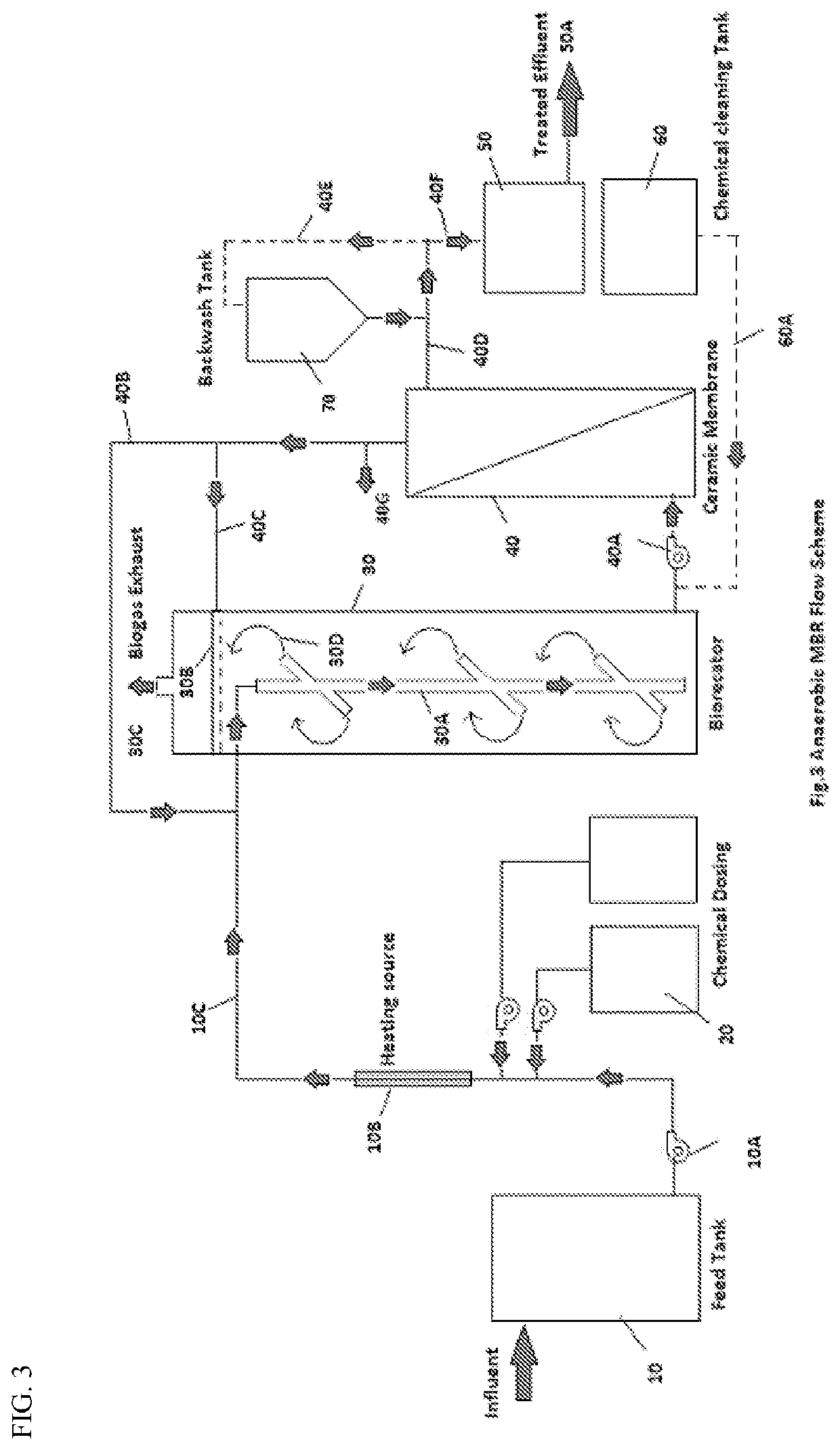Method of treating high strength wastewater by anaerobic bio reactor
a bioreactor and high-strength technology, applied in biological water/sewage treatment, cell components, membranes, etc., to achieve the effect of low operating cos
- Summary
- Abstract
- Description
- Claims
- Application Information
AI Technical Summary
Benefits of technology
Problems solved by technology
Method used
Image
Examples
example-1
Study with Glucose Water
[0072]In this part of the study reactor was run with simulated water having glucose as contributor of COD and BOD and other constituent for alkalinity, TDS and macro / micro nutrient balance. The System was run as per the flow scheme shown in FIG. 3. This was the initial phase of study so reactor was operated at low organic loading by controlling flux through the membrane. Initially reactor was operated at 5000 mg / lit feed COD and then gradually this COD is increased to 15000 mg / lit. With increasing feed COD there was gradual increase in reactor HRT. Gradually HRT of reactor was increased to 70 hours from 32 hours initially. This was done to maintain organic loading of the reactor and avoid shock loading during start up time. With increase of COD there was increase in MLSS also and it increased to 25000 mg / lit at the feed COD of 14000 mg / lit. During the trial COD loading of the reactor was in the range of 3.4 to 4.2 Kg / m3·day.
[0073]
TABLE 1HRTMLSSFeed CODCOD Red...
example-2
Study with Dairy Wastewater
[0079]Study of dairy wastewater was conducted with the similar flow scheme as shown in FIG. 3. Reactor temperature was kept at 37° C., which is in the mesophilic range. Simulated water having dairy wastewater was used as feed. Micronutrients were added to the feed water. Composition of the wastewater is shown in Table 4.
[0080]
TABLE 4composition of dairy wastewaterComponent% ContributionCarbohydrates52.3Proteins6.6Sugar34.9Fat6.2
[0081]With dairy wastewater, system was operated for 123 days continuously. Stable reactor performance has been observed and COD reduction was maintained at 98% as shown FIG. 7.
[0082]Mass balance for dairy wastewater was done to understand the progress in terms of hydrolysis, acidification and Methanogenesis.
[0083]Details are tabulated in Table 5.
[0084]
TABLE 5ParametersUnitValueAverage gas generation per Kg of CODM3 / Kg / day0.26% Hydrolysis%68.00% Acidification%72.84% Methanogenesis%67.76
[0085]Gas generation in case of dairy waste tri...
example-3
Study with Brewery Wastewater
[0086]This process was studied with simulated brewery wastewater having 6000-ppm average feed COD. During acclimatization phase the reactor was fed with simulated wastewater. Same flow scheme was followed as shown in FIG. 3. It took almost 50 days to achieve 98% COD reduction from the system after changing feed water character. Composition of feed water is shown in
[0087]
TABLE 6NameConc, ppmSolutionAmmonium Sulphate11Nitrogen sourceDisodium hydrogen phosphate140Phosphate source &bufferEthanol3.54C-sourceMalt extract1000C-sourceMaltose860C-sourcePeptone150C-sourceYeast extract500C-source
[0088]For the initial few days the reactor was operated at HRT of 70 hours to stabilize the system and after that HRT was gradually reduced to 30 hours. Then operated at 30 hours HRT and 5 Kg COD loading. At this condition reactor shows 98% COD reduction. COD reduction was observed to be maintained during continuous trial of 100 days.
[0089]Mass balance study for this trial ...
PUM
| Property | Measurement | Unit |
|---|---|---|
| temperature | aaaaa | aaaaa |
| temperature | aaaaa | aaaaa |
| velocity | aaaaa | aaaaa |
Abstract
Description
Claims
Application Information
 Login to View More
Login to View More - R&D
- Intellectual Property
- Life Sciences
- Materials
- Tech Scout
- Unparalleled Data Quality
- Higher Quality Content
- 60% Fewer Hallucinations
Browse by: Latest US Patents, China's latest patents, Technical Efficacy Thesaurus, Application Domain, Technology Topic, Popular Technical Reports.
© 2025 PatSnap. All rights reserved.Legal|Privacy policy|Modern Slavery Act Transparency Statement|Sitemap|About US| Contact US: help@patsnap.com



